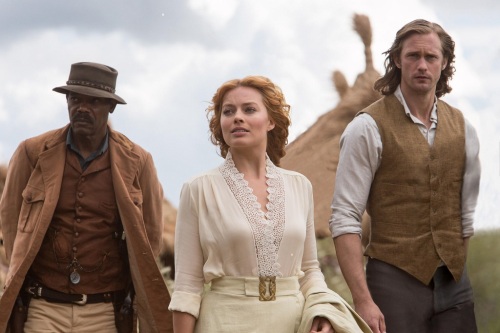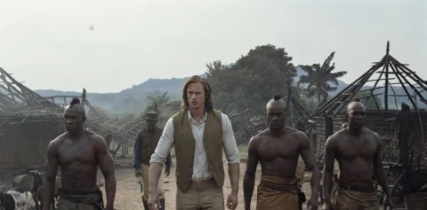
Williams, Jane and Tarzan try to figure out if the village they’re in is real or green screen. (All images: Warner Bros)
Assuming you like action adventure movies to begin with, whether or not you enjoy The Legend of Tarzan depends at least partly on how much history you want in your historical period adventures. Tarzan adventures are usually set in an entirely mythical Africa, so the advance detail about The Legend of Tarzan that intrigued me the most was that it is set during King Leopold of Belgium’s genocidal colonial occupation of the Congo. (If you want just one reason why Africans in particular and people of color in general really dislike European and American colonialism, look up the history of the Congo Free State some time. It will make you sick.) Even better, one of the main characters is a fictional version of a real black American historian, George Washington Williams, who went to Africa and Europe in the 1880’s specifically to expose the Belgian atrocities.
Taken just as a period adventure and an addition to the Tarzan mythos, Legend is far more entertaining than I expected it to be (admittedly, my expectations were not especially high). Alexander Skarsgard is taciturn and intense as the resocialized “ape man,” and his co-stars hold their own: Margot Robbie’s strong-willed Jane, working almost successfully against her character’s inevitable damseling; Christoph Waltz’s creepily ambitious mastermind of the Congo exploitation; and Samuel L Jackson playing Williams as his most popular screen persona, by turns smartass, kickass, and deeply humane.
The emotional heart of the movie is the ongoing romance between Tarzan and Jane, and their shared love for the Congo, their childhood home, and for its indigenous people and animals. So the movie makes almost as much of the Belgian threat as it does of the danger to Tarzan and Jane, whom Waltz’s character plans to barter to a vengeful tribal chief (Hounsou) for access to the diamond mines in his lands. If you don’t mind a sometimes deliberate pace, it has a good balance of action and drama. It’s also very eye filling, particularly the sequences which use panoramic film shots of savannahs, rain forests, and jungle rivers, composited in as backgrounds (the live action was shot entirely in a studio in England).
So, for pure entertainment, especially if you are already a fan of Tarzan, or of period action movies with a nice dash of romance and humor, you’ll probably like this one a lot.
There’s that just, though, the one I mentioned 3 paragraphs back. Take it just as an adventure in a fictional Africa, and it’s fine. But the filmmakers didn’t stick to fiction; they included that historical character, Williams, and the very real Belgian rape of the Congo. By including those, they surely wanted to redress some of the racist and colonial issues in the original Edgar Rice Burroughs novels and in many earlier Tarzan movies. Unfortunately, the historical elements have the reverse effect: they make those problems almost impossible to ignore.
First, there’s Tarzan himself: the most famous representation of the “noble savage” archetype, which became popular in the industrialized Western particularly in the late 19th century. Tarzan and characters like him represent the “civilized” person’s nostalgia for our lost rural past and our separation from nature. The Noble Savage is always portrayed as superior to Civilized Man because he is not corrupted by civilization, and lives in harmony with the “jungle” or “wilderness” and with “savage beasts” (to use the language of the era) – all those things that civilized people fear. The Noble Savage is often invested with almost superhuman senses plus extraordinary strength and athleticism, because of the demands of living in the wild and having to hunt and fight to survive. Kipling’s Mowgli (not Disney’s) is another famous example, and Howard’s Conan and Fenimore Cooper’s Mohicans are variations.
In literary terms, this may seem an interesting Victorian archetype – one that clearly still appeals to us “civilized humans,” given how many times Tarzan has hit the big screen. In post-colonial terms, though it staggers under the weight of an unintentional irony. There were still plenty of “noble savages” in many parts of the world in Burroughs’ time – people who lived in relatively pristine environments which they understood intimately, and which they inhabited far more sustainably than the “civilized” nations. And without exception in the 19th century, these real world “noble savages” so admired in Western literature were precisely the indigenous peoples whom “civilized” Western men were aggressively enslaving, assimilating and exterminating, in order to occupy their lands and exploit their natural resources.
Do you begin to see the problem with portraying the ideal “noble savage” and savior of Africa as a white man?
This movie tries hard to get past that problem, first, by using the story of the Belgian Congo as a central plot point. Second, it treats the African characters with more respect, portraying them not as “noble savages” nor even as the generic “natives” of earlier film Tarzans. They are individuals, families and communities with individual motivations and distinct (possibly real) cultures. And there’s second lead Sam Jackson, the black man who kickstarts the whole adventure, because he needs Tarzan’s help to to expose Leopold’s horrific abuses. In those ways, the movie is a definite improvement over most older versions of Tarzan.
But it’s just as much a huge missed opportunity. The rape of the Congo is supposed to be the main motivation for the heroes – yet we never see any of it, though it has already begun with the building of railroads and forts. Even the villains’ attack on the home village is incredibly sanitized, with just a few burned huts, one murder and a few young men taken away in chains. No beatings, no blood, no rape, no massacre, none of the atrocities that would have accompanied such an attack in the real world.
Jackson’s character, a Civil War veteran, is old enough to know many, many ex-slaves. Yet he never mentions American slavery, which should have been a prime motivation for him. And he, the most important and effective black man in the story, is not an African, but an entirely assimilated black American. Yes, Williams was actually there, and he was a black American. But wouldn’t it have been more interesting if the primary instigator of the story, the person ready to move heaven and earth (and the very reluctant Tarzan) to save the Congo was a Congolese character fighting for his home?
Ultimately, this movie brings us back to the essential problem with any story about Tarzan, and it’s the same problem we see with many other post-colonial stories such as Avatar and Dances with Wolves. The hero of any Tarzan story is always Tarzan, the white man. In this movie as in every other Tarzan story I’ve ever seen, the indigenous people of Africa serve, once again, as background characters in their own country and their own history – background to a contest between two white men for the control of the Africans’ continent.
What would it take to tell the story of the Belgian Congo through the eyes of that Congolese hero? I don’t know, but it’s surely worth doing.
Postscript: While I was drafting this, the internet (or at least the Potterhead part of it) burst into flames over J.K. Rowling incorporating elements of American Indian (specifically Navajo) mythology in her History of North American Magic (“Magical natives” is another very common element of the “noble savage” archetype). I’m adding here a link to the National Geographic article on the controversy, since it discusses the “noble savage” archetype along with several other destructive ways that Indians, Africans, and other traditional societies are portrayed in Western literature.

A very balanced critique and I am also troubled by some of the white normative blindness in the premise of the noble savage, along with some cruel historical ironies it carries with it however well intentioned.
By: Annis pratt on July 17, 2016
at 7:44 pm
Good, concise analysis. As someone who took multiple African history classes in college I was happy to see a mainstream Hollywood film tackle this era, though I had the same reservations as you. Most likely they omitted the worst aspects of the Congo “Free” State because they wanted a family friendly PG-13 rating. Massacres, rapes, torture and amputations as punishment would guarantee an R, which would be problematic for an iconic character who’s most recent film was made by Disney.
By: djgarcia94 on March 7, 2017
at 3:14 pm
Thanks for commenting, DJ. I’m sorry I didn’t see this sooner, but I’ve had a very busy spring!(Now that you’ve had a comment is approved, you are released from the approvals queue, so if you comment again, it will post immediately)
Yes, I’m sure you are right that showing more atrocities would have trashed their PG rating. I still wish they had found a way to at least indicate the scale of the atrocities: maybe just a mention of numbers of massacred/enslaved villages, how many died building those railroads, a quick glimpse of a few torture survivors.
Ah, well. At least its an improvement over how past incarnations of Tarzan portrayed Africans.
By: kshayes513 on July 3, 2017
at 11:56 am